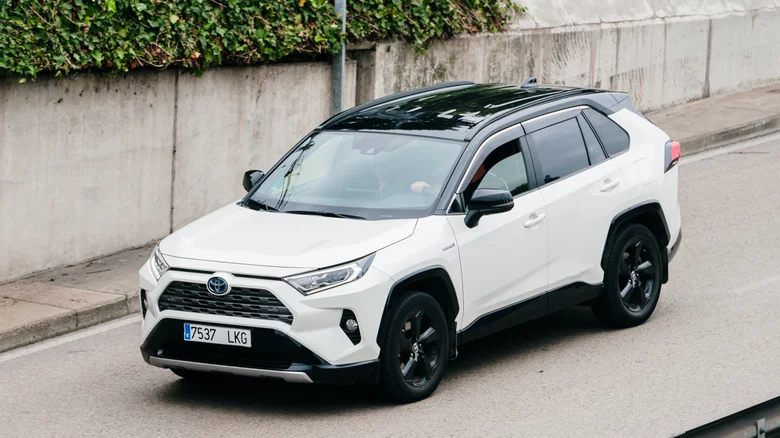The Toyota RAV4 has long been a cornerstone of the compact SUV market, consistently ranking as one of the best-selling vehicles in the United States. With the 2026 model on the horizon, excitement is building among car enthusiasts and loyal RAV4 drivers alike. While Toyota has confirmed the next-generation RAV4, details remain scarce, leaving plenty of room for speculation and anticipation. Let’s explore what we know so far, what changes are likely, and why the 2026 RAV4 could be a game-changer in the competitive SUV landscape.
The RAV4 Legacy: A Best-Selling Icon
The Toyota RAV4 has earned its reputation as a reliable, versatile, and affordable SUV. In 2024, it surpassed even the Ford F-150 to become the best-selling vehicle in the U.S., with an impressive 475,193 units sold. Its winning formula combines practicality, advanced technology, and a range of powertrain options, making it a favorite among families, commuters, and adventure seekers alike.
Techfullnews recently rated the 2024 RAV4 a stellar 9 out of 10, praising its affordability, spacious cargo area, and advanced features like the panoramic roof and driver-assistance systems. While it may not be the most thrilling SUV on the market, its consistent performance and value have solidified its place as a top contender.
What’s Next for the 2026 Toyota RAV4?

Toyota has kept details about the 2026 RAV4 tightly under wraps, but that hasn’t stopped enthusiasts from making educated predictions. Here’s a breakdown of what we might expect based on industry trends, Toyota’s recent moves, and the evolution of the RAV4 platform:
1. Exterior Design: A Blockier, Modern Look
The 2026 RAV4 is expected to receive a refreshed exterior design, aligning with Toyota’s recent design language. Inspired by the 2025 4Runner, the new RAV4 could adopt a blockier, more rugged appearance. This shift would not only modernize its look but also enhance its appeal to buyers seeking a more aggressive and adventurous aesthetic.
While the current RAV4 is built on the Toyota New Global Architecture (TNGA), which provides excellent rigidity, stability, and handling, the 2026 model is unlikely to undergo significant structural changes. Instead, Toyota is expected to focus on refining the design to keep it fresh and competitive.
2. Powertrain Options: Going Fully Hybrid
One of the most significant changes anticipated for the 2026 RAV4 is the discontinuation of the gas-only engine option. Following in the footsteps of the 2025 Toyota Camry, which is now offered exclusively as a hybrid, the RAV4 is expected to go fully hybrid as well.
This move aligns with Toyota’s broader strategy of prioritizing hybrid and electric vehicles (EVs) as the automotive industry shifts toward sustainability. The 2026 RAV4 will likely retain its hybrid and plug-in hybrid variants, offering drivers a balance of efficiency and performance. Additionally, we could see improvements in battery technology, resulting in extended range and faster charging times for the plug-in hybrid model.
3. Interior Upgrades: Functionality Meets Modern Style
The RAV4 has always been praised for its practicality and spacious interior, and the 2026 model is expected to build on this foundation. While functionality and cargo space will remain priorities, Toyota may introduce upgrades to the dashboard, materials, and overall styling to bring the RAV4 in line with its newer models.
Expect a more refined and tech-forward cabin, with enhanced infotainment features, improved connectivity, and possibly even a larger touchscreen display. These changes would not only elevate the driving experience but also help the RAV4 compete with rivals that have raised the bar for interior luxury and technology.
4. Performance: Zippy Acceleration and Enhanced Handling
The RAV4 has never been a slouch when it comes to performance, and the 2026 model is expected to continue this trend. With its hybrid powertrain, the new RAV4 should deliver zippy acceleration and smooth handling, making it a joy to drive in both city and highway conditions.
Toyota may also fine-tune the suspension and steering to enhance ride comfort and responsiveness, ensuring that the RAV4 remains a top choice for drivers who value both performance and practicality.
Why the 2026 RAV4 Matters
The 2026 Toyota RAV4 isn’t just another update—it represents Toyota’s commitment to innovation, sustainability, and meeting the evolving needs of drivers. By potentially going fully hybrid, the RAV4 could set a new standard for eco-friendly SUVs, appealing to environmentally conscious buyers without compromising on performance or versatility.
Moreover, the RAV4’s continued success is a testament to Toyota’s ability to balance tradition and innovation. As one of the most trusted names in the automotive industry, Toyota has consistently delivered vehicles that combine reliability, value, and cutting-edge technology. The 2026 RAV4 is poised to carry on this legacy, offering drivers a vehicle that’s as practical as it is forward-thinking.
Final Thoughts
While details about the 2026 Toyota RAV4 remain limited, the anticipation surrounding its release is undeniable. With its potential shift to a fully hybrid lineup, modernized design, and upgraded interior, the next-generation RAV4 could redefine what drivers expect from a compact SUV.
For now, enthusiasts will have to wait for official announcements from Toyota. But one thing is certain: the 2026 RAV4 has big shoes to fill, and if Toyota’s track record is any indication, it’s up to the challenge. Stay tuned for updates as we get closer to its release—this is one SUV you won’t want to miss.








